Anyone using/tried the E28-2G4M27S 2.4Ghz LoRa SX1280 27dB module?
-
I just now noticed that Andreas Spiess did a youtube about the same chip, though different model Ebyte modue:
https://www.youtube.com/watch?v=JYThKZCflJcSmall world: it turns out he also made a breakout board for himself in order to test the module. It doesn't look pin compatible with my module, however, as it has only 14 pins on its pinout, whereas mine has 16. Also, not sure whether Andreas posted his breakout board anywhere. I would expect so. He has a github, but it has almost no descriptive material in it other than the titles, so it's hard to know what is truly what.
Worthy of note: the module he chose is less capable than the one I picked: substantially less potential transmit power, and also, according to Ebyte specs, somewhat inferior receive sensitivity.
Fortunately, he does post links to the libraries that he used to operate the SX1280 chip, so that's probably a good starting point, or at least a point of comparison.
To avoid interference he does report having to turn off the wifi on his esp32 that's driving the module, so having an ethernet connection for the gateway probably makes the most sense. The good news is that with LoRa, you should need only one such gateway, and you can probably put it just about anywhere and still have a good, solid RF connection to your nodes. Probably a raspberry pi could serve that purpose for a low effort solution, though I may go for an arduino-ethernet solution because that may turn out to be even easier, and probably without the need for ongoing updates and security maintenance. i.e. it should "just work". Perhaps setting the target IP address with a dipswitch would avoid any future need to revisit the firmware. Also, a raspberry pi's attack surface seems orders of magnitude larger than a more basic, hardware oriented solution.
Regardless, the next step for me is to wire it up and get it to play ping pong with another node. Then I'll be able to quickly determine whether ambient wi-fi signals in the environment will be a cause for concern or not. I suspect not, but sending thousands/millions of test packets while measuring for packet loss will tell the tale definitively.
I have one node with a 100uF capacitor (pictured in my preceding post), and another node without, so I'll try to determine whether it makes any practical difference or not. I'm guessing that it were powered by a coincell, it's essential, but if by two AA's in close proximity, probably not (though if the batteries are weak, maybe it would, at the margin, still help).
-
Here's what the breadboarded LoRa transmitter node looks like:
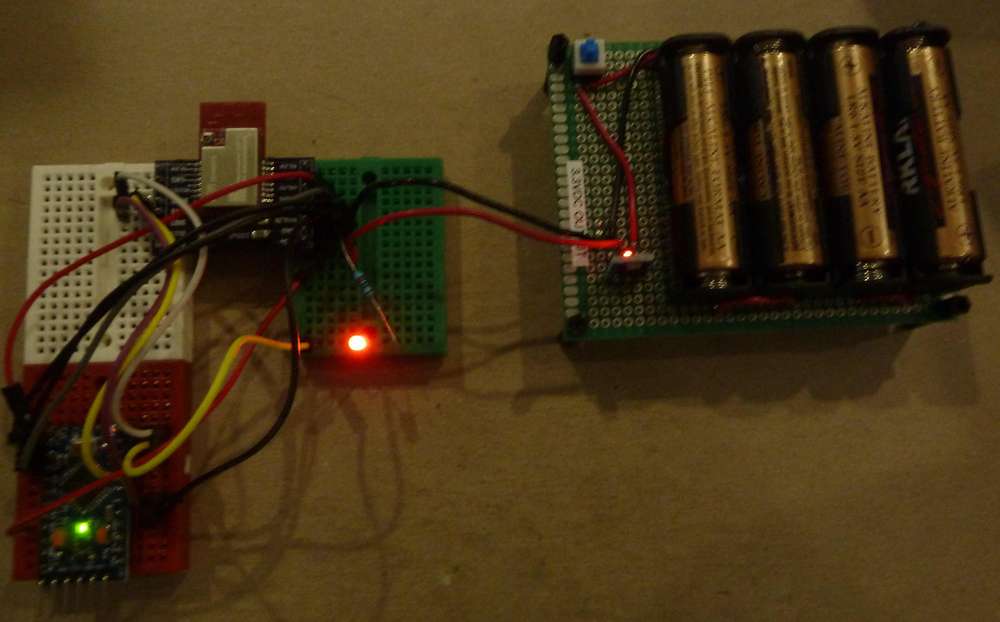
It turns out you need an external LED for status purposes, because the typical Pin 13 LED isn't available because it's in use by the SPI interface as a clock pin. The LED blinks every time a packet is transmitted (about once a second). In the picture here, I managed to photograph it at the very moment of blinking after a transmission.
The wiring pinout is given in the header file of the library example application, so no thinking required. I'm using a generic pro mini with the 5v LDO removed, and I then programmed it using the Arduino IDE as a 3.3v 8Mhz pro mini using the library's example transmitter setup sketch downloaded from: https://github.com/StuartsProjects/SX12XX-LoRa
-
Here's what the breadboarded receiver looks like:

Every time it receives a packet from the transmitter (pictured in the immediately preceding post), it blinks the red LED.
Simple to assemble. Both transmitter and receiver worked flawlessly the very first time I put it all together. :-)
Next up: do range testing around the house and run enough packets to determine whether any ever get lost, and, if so, what the rate of loss is. I'll also dial down the transmit power to see how low is still sufficient.
-
@NeverDie - thanks for the prolific work. There is alot to consider here. I reviewd the Andreas Spiess video...wonderful as usual. I'll have lots of questions after I set-up my own station to poke around.
On your range tests: The tests that I have seen that are most effective are those where the transmitters are always sending. The recievers have packet counting stats to give evidence. And for a topper, the reciever sends an ack that can also meausre packett success. Fun stuff.
-
@NeverDie - thanks for the prolific work. There is alot to consider here. I reviewd the Andreas Spiess video...wonderful as usual. I'll have lots of questions after I set-up my own station to poke around.
On your range tests: The tests that I have seen that are most effective are those where the transmitters are always sending. The recievers have packet counting stats to give evidence. And for a topper, the reciever sends an ack that can also meausre packett success. Fun stuff.
@Larson Yup. It will be fun to see how LoRa performs at 2.4Ghz.:grin:
Since LoRa potentially has such long transmission windows (at the extreme, as much as one second), it will be important to keep the transmissions of different nodes from overlapping and for recovering (and avoiding future overlaps) if they do.
-
In case anyone is wondering, the default receiver output using the library's receiver setup example looks like this:
17:05:02 Apr 17 2022 V1.0 104_LoRa_Receiver_Detailed_Setup Starting LoRa Device found SX1280,PACKET_TYPE_LORA,2444999936hz,SF7,BW406250,CR4:5 SX1280,PACKET_TYPE_LORA,Preamble_12,Explicit,PayloadL_255,CRC_ON,IQ_NORMAL,LNAgain_HighSensitivity Reg 0 1 2 3 4 5 6 7 8 9 A B C D E F 0x900 80 FF 77 41 20 FA BC 13 C1 80 00 00 00 00 00 61 0x910 9C 44 00 00 00 19 00 00 00 19 87 65 43 21 7F FF 0x920 FF FF FF 00 70 37 12 50 D0 80 00 C0 5F D2 8F 0A 0x930 00 C0 00 00 00 24 00 21 28 B0 30 0D 01 51 63 0C 0x940 58 0B 32 0A 16 24 6B 96 00 18 00 00 00 00 00 00 0x950 00 00 00 00 00 00 00 00 00 00 00 00 00 00 00 00 0x960 00 00 00 00 00 00 00 00 00 00 FF FF FF FF FF FF 0x970 FF FF FF FF FF FF FF FF FF FF FF FF FF FF FF 04 0x980 00 0B 18 70 00 00 00 4C 00 F0 64 00 00 00 00 00 0x990 00 00 00 00 00 00 00 00 00 00 00 00 00 00 00 00 0x9A0 00 08 EC B8 9D 8A E6 66 04 00 00 00 00 00 00 00 0x9B0 00 08 EC B8 9D 8A E6 66 04 00 00 00 00 00 00 00 0x9C0 00 16 00 3F E8 01 FF FF FF FF 5E 4D 25 10 55 55 0x9D0 55 55 55 55 55 55 55 55 55 55 55 55 55 00 00 00 0x9E0 00 00 00 00 00 00 00 00 00 00 00 00 00 00 00 00 0x9F0 00 00 00 00 00 00 00 00 00 00 00 00 00 00 00 00 Receiver ready - RXBUFFER_SIZE 32 4s Hello World 1234567890*,CRC,DAAB,RSSI,-51dBm,SNR,13dB,Length,23,Packets,1,Errors,0,IRQreg,8012 5s Hello World 1234567890*,CRC,DAAB,RSSI,-51dBm,SNR,13dB,Length,23,Packets,2,Errors,0,IRQreg,8012 6s Hello World 1234567890*,CRC,DAAB,RSSI,-51dBm,SNR,8dB,Length,23,Packets,3,Errors,0,IRQreg,8012 7s Hello World 1234567890*,CRC,DAAB,RSSI,-51dBm,SNR,13dB,Length,23,Packets,4,Errors,0,IRQreg,8012 8s Hello World 1234567890*,CRC,DAAB,RSSI,-52dBm,SNR,12dB,Length,23,Packets,5,Errors,0,IRQreg,8012 9s Hello World 1234567890*,CRC,DAAB,RSSI,-51dBm,SNR,14dB,Length,23,Packets,6,Errors,0,IRQreg,8012 10s Hello World 1234567890*,CRC,DAAB,RSSI,-51dBm,SNR,13dB,Length,23,Packets,7,Errors,0,IRQreg,8012 11s Hello World 1234567890*,CRC,DAAB,RSSI,-52dBm,SNR,14dB,Length,23,Packets,8,Errors,0,IRQreg,8012 12s Hello World 1234567890*,CRC,DAAB,RSSI,-51dBm,SNR,13dB,Length,23,Packets,9,Errors,0,IRQreg,8012 13s Hello World 1234567890*,CRC,DAAB,RSSI,-51dBm,SNR,13dB,Length,23,Packets,10,Errors,0,IRQreg,8012 14s Hello World 1234567890*,CRC,DAAB,RSSI,-51dBm,SNR,13dB,Length,23,Packets,11,Errors,0,IRQreg,8012 15s Hello World 1234567890*,CRC,DAAB,RSSI,-51dBm,SNR,13dB,Length,23,Packets,12,Errors,0,IRQreg,8012 16s Hello World 1234567890*,CRC,DAAB,RSSI,-51dBm,SNR,13dB,Length,23,Packets,13,Errors,0,IRQreg,8012 17s Hello World 1234567890*,CRC,DAAB,RSSI,-51dBm,SNR,12dB,Length,23,Packets,14,Errors,0,IRQreg,8012 18s Hello World 1234567890*,CRC,DAAB,RSSI,-51dBm,SNR,13dB,Length,23,Packets,15,Errors,0,IRQreg,8012 19s Hello World 1234567890*,CRC,DAAB,RSSI,-51dBm,SNR,12dB,Length,23,Packets,16,Errors,0,IRQreg,8012 20s Hello World 1234567890*,CRC,DAAB,RSSI,-51dBm,SNR,13dB,Length,23,Packets,17,Errors,0,IRQreg,8012 21s Hello World 1234567890*,CRC,DAAB,RSSI,-51dBm,SNR,13dB,Length,23,Packets,18,Errors,0,IRQreg,8012 22s Hello World 1234567890*,CRC,DAAB,RSSI,-51dBm,SNR,13dB,Length,23,Packets,19,Errors,0,IRQreg,8012 24s Hello World 1234567890*,CRC,DAAB,RSSI,-51dBm,SNR,13dB,Length,23,Packets,20,Errors,0,IRQreg,8012 25s Hello World 1234567890*,CRC,DAAB,RSSI,-51dBm,SNR,13dB,Length,23,Packets,21,Errors,0,IRQreg,8012 26s Hello World 1234567890*,CRC,DAAB,RSSI,-51dBm,SNR,13dB,Length,23,Packets,22,Errors,0,IRQreg,8012 27s Hello World 1234567890*,CRC,DAAB,RSSI,-51dBm,SNR,13dB,Length,23,Packets,23,Errors,0,IRQreg,8012 28s Hello World 1234567890*,CRC,DAAB,RSSI,-52dBm,SNR,11dB,Length,23,Packets,24,Errors,0,IRQreg,8012 29s Hello World 1234567890*,CRC,DAAB,RSSI,-53dBm,SNR,13dB,Length,23,Packets,25,Errors,0,IRQreg,8012 30s Hello World 1234567890*,CRC,DAAB,RSSI,-53dBm,SNR,13dB,Length,23,Packets,26,Errors,0,IRQreg,8012 31s Hello World 1234567890*,CRC,DAAB,RSSI,-54dBm,SNR,12dB,Length,23,Packets,27,Errors,0,IRQreg,8012 32s Hello World 1234567890*,CRC,DAAB,RSSI,-54dBm,SNR,13dB,Length,23,Packets,28,Errors,0,IRQreg,8012 33s Hello World 1234567890*,CRC,DAAB,RSSI,-54dBm,SNR,12dB,Length,23,Packets,29,Errors,0,IRQreg,8012 34s Hello World 1234567890*,CRC,DAAB,RSSI,-54dBm,SNR,13dB,Length,23,Packets,30,Errors,0,IRQreg,8012 35s Hello World 1234567890*,CRC,DAAB,RSSI,-54dBm,SNR,12dB,Length,23,Packets,31,Errors,0,IRQreg,8012 36s Hello World 1234567890*,CRC,DAAB,RSSI,-54dBm,SNR,13dB,Length,23,Packets,32,Errors,0,IRQreg,8012 37s Hello World 1234567890*,CRC,DAAB,RSSI,-53dBm,SNR,3dB,Length,23,Packets,33,Errors,0,IRQreg,8012 38s Hello World 1234567890*,CRC,DAAB,RSSI,-54dBm,SNR,14dB,Length,23,Packets,34,Errors,0,IRQreg,8012 39s Hello World 1234567890*,CRC,DAAB,RSSI,-54dBm,SNR,13dB,Length,23,Packets,35,Errors,0,IRQreg,8012 40s Hello World 1234567890*,CRC,DAAB,RSSI,-54dBm,SNR,13dB,Length,23,Packets,36,Errors,0,IRQreg,8012 41s Hello World 1234567890*,CRC,DAAB,RSSI,-54dBm,SNR,13dB,Length,23,Packets,37,Errors,0,IRQreg,8012 42s Hello World 1234567890*,CRC,DAAB,RSSI,-54dBm,SNR,13dB,Length,23,Packets,38,Errors,0,IRQreg,8012 43s Hello World 1234567890*,CRC,DAAB,RSSI,-54dBm,SNR,13dB,Length,23,Packets,39,Errors,0,IRQreg,8012 44s Hello World 1234567890*,CRC,DAAB,RSSI,-54dBm,SNR,13dB,Length,23,Packets,40,Errors,0,IRQreg,8012 45s Hello World 1234567890*,CRC,DAAB,RSSI,-54dBm,SNR,13dB,Length,23,Packets,41,Errors,0,IRQreg,8012 46s Hello World 1234567890*,CRC,DAAB,RSSI,-54dBm,SNR,13dB,Length,23,Packets,42,Errors,0,IRQreg,8012 47s Hello World 1234567890*,CRC,DAAB,RSSI,-54dBm,SNR,13dB,Length,23,Packets,43,Errors,0,IRQreg,8012 48s Hello World 1234567890*,CRC,DAAB,RSSI,-54dBm,SNR,11dB,Length,23,Packets,44,Errors,0,IRQreg,8012 49s Hello World 1234567890*,CRC,DAAB,RSSI,-55dBm,SNR,13dB,Length,23,Packets,45,Errors,0,IRQreg,8012 50s Hello World 1234567890*,CRC,DAAB,RSSI,-54dBm,SNR,12dB,Length,23,Packets,46,Errors,0,IRQreg,8012 52s Hello World 1234567890*,CRC,DAAB,RSSI,-54dBm,SNR,13dB,Length,23,Packets,47,Errors,0,IRQreg,8012 53s Hello World 1234567890*,CRC,DAAB,RSSI,-52dBm,SNR,2dB,Length,23,Packets,48,Errors,0,IRQreg,8012 54s Hello World 1234567890*,CRC,DAAB,RSSI,-54dBm,SNR,13dB,Length,23,Packets,49,Errors,0,IRQreg,8012 55s Hello World 1234567890*,CRC,DAAB,RSSI,-54dBm,SNR,13dB,Length,23,Packets,50,Errors,0,IRQreg,8012 56s Hello World 1234567890*,CRC,DAAB,RSSI,-55dBm,SNR,14dB,Length,23,Packets,51,Errors,0,IRQreg,8012 57s Hello World 1234567890*,CRC,DAAB,RSSI,-54dBm,SNR,13dB,Length,23,Packets,52,Errors,0,IRQreg,8012 58s Hello World 1234567890*,CRC,DAAB,RSSI,-54dBm,SNR,13dB,Length,23,Packets,53,Errors,0,IRQreg,8012 59s Hello World 1234567890*,CRC,DAAB,RSSI,-54dBm,SNR,13dB,Length,23,Packets,54,Errors,0,IRQreg,8012 60s Hello World 1234567890*,CRC,DAAB,RSSI,-54dBm,SNR,13dB,Length,23,Packets,55,Errors,0,IRQreg,8012 61s Hello World 1234567890*,CRC,DAAB,RSSI,-54dBm,SNR,12dB,Length,23,Packets,56,Errors,0,IRQreg,8012 62s Hello World 1234567890*,CRC,DAAB,RSSI,-55dBm,SNR,14dB,Length,23,Packets,57,Errors,0,IRQreg,8012 63s Hello World 1234567890*,CRC,DAAB,RSSI,-54dBm,SNR,13dB,Length,23,Packets,58,Errors,0,IRQreg,8012 64s Hello World 1234567890*,CRC,DAAB,RSSI,-53dBm,SNR,4dB,Length,23,Packets,59,Errors,0,IRQreg,8012 65s Hello World 1234567890*,CRC,DAAB,RSSI,-53dBm,SNR,13dB,Length,23,Packets,60,Errors,0,IRQreg,8012 66s Hello World 1234567890*,CRC,DAAB,RSSI,-53dBm,SNR,12dB,Length,23,Packets,61,Errors,0,IRQreg,8012 67s Hello World 1234567890*,CRC,DAAB,RSSI,-53dBm,SNR,13dB,Length,23,Packets,62,Errors,0,IRQreg,8012 68s Hello World 1234567890*,CRC,DAAB,RSSI,-53dBm,SNR,13dB,Length,23,Packets,63,Errors,0,IRQreg,8012 69s Hello World 1234567890*,CRC,DAAB,RSSI,-54dBm,SNR,13dB,Length,23,Packets,64,Errors,0,IRQreg,8012 70s Hello World 1234567890*,CRC,DAAB,RSSI,-53dBm,SNR,13dB,Length,23,Packets,65,Errors,0,IRQreg,8012 71s Hello World 1234567890*,CRC,DAAB,RSSI,-52dBm,SNR,13dB,Length,23,Packets,66,Errors,0,IRQreg,8012 72s Hello World 1234567890*,CRC,DAAB,RSSI,-49dBm,SNR,13dB,Length,23,Packets,67,Errors,0,IRQreg,8012So, an obvious thing to do would be to send an incrementing count in each transmitted package as a way to detect lost packets.
Interesting that it displays the SNR. AFAIK, this is the first chip I've wrong across which offers that up. It might be handy for identifying a clear channel. Or, less elegantly, one could just check to see if, based on time, an expected packet doesn't arrive. The one virtue in that is that it would require no code change at all.
-
If I put it further away, you can see that it does encounter either missing packets with the generic configuration and/or packets that are received but which fail CRC:
2374s Hello World 1234567890*,CRC,DAAB,RSSI,-85dBm,SNR,-2dB,Length,23,Packets,79,Errors,0,IRQreg,8012 2375s Hello World 1234567890*,CRC,DAAB,RSSI,-79dBm,SNR,14dB,Length,23,Packets,80,Errors,0,IRQreg,8012 2376s PacketError,RSSI,-77dBm,SNR,5dB,Length,23,Packets,80,Errors,1,IRQreg,8052,IRQ_RX_DONE,IRQ_HEADER_VALID,IRQ_CRC_ERROR,IRQ_PREAMBLE_DETECTED 2377s Hello World 1234567890*,CRC,DAAB,RSSI,-79dBm,SNR,12dB,Length,23,Packets,81,Errors,1,IRQreg,8012 2378s PacketError,RSSI,-79dBm,SNR,-9dB,Length,23,Packets,81,Errors,2,IRQreg,8052,IRQ_RX_DONE,IRQ_HEADER_VALID,IRQ_CRC_ERROR,IRQ_PREAMBLE_DETECTED 2381s PacketError,RSSI,-79dBm,SNR,12dB,Length,23,Packets,81,Errors,3,IRQreg,8052,IRQ_RX_DONE,IRQ_HEADER_VALID,IRQ_CRC_ERROR,IRQ_PREAMBLE_DETECTED 2382s Hello World 1234567890*,CRC,DAAB,RSSI,-78dBm,SNR,-1dB,Length,23,Packets,82,Errors,3,IRQreg,8012 2383s PacketError,RSSI,-83dBm,SNR,12dB,Length,23,Packets,82,Errors,4,IRQreg,8052,IRQ_RX_DONE,IRQ_HEADER_VALID,IRQ_CRC_ERROR,IRQ_PREAMBLE_DETECTED 2384s Hello World 1234567890*,CRC,DAAB,RSSI,-80dBm,SNR,5dB,Length,23,Packets,83,Errors,4,IRQreg,8012 2385s PacketError,RSSI,-81dBm,SNR,-10dB,Length,23,Packets,83,Errors,5,IRQreg,8052,IRQ_RX_DONE,IRQ_HEADER_VALID,IRQ_CRC_ERROR,IRQ_PREAMBLE_DETECTED 2388s Hello World 1234567890*,CRC,DAAB,RSSI,-87dBm,SNR,-5dB,Length,23,Packets,84,Errors,5,IRQreg,8012 2390s Hello World 1234567890*,CRC,DAAB,RSSI,-75dBm,SNR,-1dB,Length,23,Packets,85,Errors,5,IRQreg,8012 2391s PacketError,RSSI,-78dBm,SNR,2dB,Length,23,Packets,85,Errors,6,IRQreg,8052,IRQ_RX_DONE,IRQ_HEADER_VALID,IRQ_CRC_ERROR,IRQ_PREAMBLE_DETECTED 2392s PacketError,RSSI,-73dBm,SNR,1dB,Length,23,Packets,85,Errors,7,IRQreg,8052,IRQ_RX_DONE,IRQ_HEADER_VALID,IRQ_CRC_ERROR,IRQ_PREAMBLE_DETECTED 2394s PacketError,RSSI,-76dBm,SNR,9dB,Length,23,Packets,85,Errors,8,IRQreg,8052,IRQ_RX_DONE,IRQ_HEADER_VALID,IRQ_CRC_ERROR,IRQ_PREAMBLE_DETECTED 2395s Hello World 1234567890*,CRC,DAAB,RSSI,-80dBm,SNR,8dB,Length,23,Packets,86,Errors,8,IRQreg,8012 2396s PacketError,RSSI,-77dBm,SNR,9dB,Length,23,Packets,86,Errors,9,IRQreg,8052,IRQ_RX_DONE,IRQ_HEADER_VALID,IRQ_CRC_ERROR,IRQ_PREAMBLE_DETECTED 2397s Hello World 1234567890*,CRC,DAAB,RSSI,-78dBm,SNR,10dB,Length,23,Packets,87,Errors,9,IRQreg,8012 2398s PacketError,RSSI,-72dBm,SNR,1dB,Length,23,Packets,87,Errors,10,IRQreg,8052,IRQ_RX_DONE,IRQ_HEADER_VALID,IRQ_CRC_ERROR,IRQ_PREAMBLE_DETECTED 2399s Hello World 1234567890*,CRC,DAAB,RSSI,-77dBm,SNR,10dB,Length,23,Packets,88,Errors,10,IRQreg,8012 2400s PacketError,RSSI,-79dBm,SNR,0dB,Length,23,Packets,88,Errors,11,IRQreg,8052,IRQ_RX_DONE,IRQ_HEADER_VALID,IRQ_CRC_ERROR,IRQ_PREAMBLE_DETECTED 2401s Hello World 1234567890*,CRC,DAAB,RSSI,-78dBm,SNR,8dB,Length,23,Packets,89,Errors,11,IRQreg,8012 2402s Hello World 1234567890*,CRC,DAAB,RSSI,-77dBm,SNR,13dB,Length,23,Packets,90,Errors,11,IRQreg,8012 2404s Hello World 1234567890*,CRC,DAAB,RSSI,-84dBm,SNR,-9dB,Length,23,Packets,91,Errors,11,IRQreg,8012 2405s Hello World 1234567890*,CRC,DAAB,RSSI,-73dBm,SNR,2dB,Length,23,Packets,92,Errors,11,IRQreg,8012 2408s Hello World 1234567890*,CRC,DAAB,RSSI,-81dBm,SNR,-7dB,Length,23,Packets,93,Errors,11,IRQreg,8012 2409s PacketError,RSSI,-71dBm,SNR,-3dB,Length,23,Packets,93,Errors,12,IRQreg,8052,IRQ_RX_DONE,IRQ_HEADER_VALID,IRQ_CRC_ERROR,IRQ_PREAMBLE_DETECTED 2410s Hello World 1234567890*,CRC,DAAB,RSSI,-73dBm,SNR,-1dB,Length,23,Packets,94,Errors,12,IRQreg,8012 2411s Hello World 1234567890*,CRC,DAAB,RSSI,-77dBm,SNR,10dB,Length,23,Packets,95,Errors,12,IRQreg,8012 2412s Hello World 1234567890*,CRC,DAAB,RSSI,-75dBm,SNR,8dB,Length,23,Packets,96,Errors,12,IRQreg,8012 2413s Hello World 1234567890*,CRC,DAAB,RSSI,-77dBm,SNR,11dB,Length,23,Packets,97,Errors,12,IRQreg,8012 2414s Hello World 1234567890*,CRC,DAAB,RSSI,-76dBm,SNR,9dB,Length,23,Packets,98,Errors,12,IRQreg,8012 2415s PacketError,RSSI,-76dBm,SNR,12dB,Length,23,Packets,98,Errors,13,IRQreg,8052,IRQ_RX_DONE,IRQ_HEADER_VALID,IRQ_CRC_ERROR,IRQ_PREAMBLE_DETECTED 2416s Hello World 1234567890*,CRC,DAAB,RSSI,-76dBm,SNR,12dB,Length,23,Packets,99,Errors,13,IRQreg,8012 2417s Hello World 1234567890*,CRC,DAAB,RSSI,-77dBm,SNR,13dB,Length,23,Packets,100,Errors,13,IRQreg,8012 2418s Hello World 1234567890*,CRC,DAAB,RSSI,-77dBm,SNR,13dB,Length,23,Packets,101,Errors,13,IRQreg,8012I'll have to take a closer look at the transmitter settings to see how they might be improved. My guess is that out-of-the-box, all the settings are turned way down for when people are setting up their first nodes. As pictured in the Andreas Spiess video, there is a LoRa calculator which helps with configuration and which can compute the corresponding link budget.
Also, I'm guessing that the trace antenna is directional, so maybe that's partly why Andreas switched to an external antenna. I think Adreas is a good youtuber with interesting content, but there's no denying that he glosses over quite a lot, perhaps to keep his audience's interest by just hitting the highlights.
Also, the SNR is all over the map,, so maybe interference really is a factor that needs to be considered, even with LoRa. We shall see. Anyway, that's why I'm testing using cheap breadboard prototypes before going all-in. If there's bad news, I'd rather find it early than late!
There could be all manner of reasons for packet failures with the generic settings, including some which are not deal-killers in themselves: use of the breadboard itself, the long wires on the breadboard, possible noise from the power supply I'm currently using, noise from the computer that's connected to it for reading the text output, etc. Perhaps the Ebyte modules themselves are defective? That would explain the deep discount at which I acquired them. Who knows. So, I'll do as Andreas did, which is go for the highest possible link budget. If I'm still getting errors after that, then surely it's some other factor than the SX1280 chip itself that's causing the problem.
-
Reporting back: it turns out that the trace antennas are highly directional, and changing the orientation on just one of them can remove 20 to 30dBa from the link budget, which is significant. I'm not sure why that is, as ESP8266's have a similar design and yet don't seem to be as sensitive to orientation. Therefore, putting an omni directiona antenna on at least the receiving node would seem to make a lot of sense.
Furthermore, the default settings used by the library appear to yield a link budget of just 123dB:

which is good for a meh transceiver, but not especially awesome for a LoRa transceiver. With such a meh link budget, it's easy to see how a poorly orientated trace antenna could severely impair the packet error rate.However, by increasing the spreading factor to 12 and narrowing the bandwidth to 200khz, it's possible to add roughly another 20dB to the link budget:

However, a big downside to this approach is that the transmission time incrases to nearly 1 second, which is a considerable energy drain. Also, the calculator only allows a max transmission power of 12.5dBm, which is well become the module;s advertised maximum transmit power. So,it has me wondering now whether some other register or pin needs to be touched in order to arrive at maximum transmission power. Presumably the SX1280 chip itself has a maximum transmit power of 12.5dBm, and further power would come from activating a power-amplifier on the module, similar to the way the RFM69 module works. However, looking at the manual, this is not the case. Rather, it appears that both the PA and the LNA are permanently activated, and it recommends setting the output power of the SX1280 to 0dBm, at which time the effective output power is 27dBm.So, I do that, and increase the spreading factor to 12, and decrease the bandwidth to 203kHz, but the overall performance is still lackluster. That the power output doesn't seem to be obviously easy to adjust is a disappointment. Overall performance falls far below what the 400Mhz AI-Thinker module can achieve, and those modules are very inexpensive (around $1-2 each).
So.... I'm disappointed. They perform far worse than even the el cheapo NRF24L01 modules that are outfitted with PA + LNA, which operate in the same 2.4Ghz band. This should not be! I'll try them next with some 2.4Ghz pigtail dipole antennas and see whether or not that yields significant improvement, even though it undermines the economics of choosing these modules in the first place. If that also fails, then I'm not sure it's worth the time, money, and effort to troubleshoot it further, especially since Andreas Spiess also wasn't sanguine about his different model 2.4Ghz Ebyte LoRa module either.
The nice thing about the Ai-Thinker LoRa modules is that they very easily accomodate a wire whip antenna (which are super cheap), whereas these Ebyte modules rely on either the trace antenna (which I now know to be problematic because of its apparent directional sensitivity) or on an IPEX connector, which increases the BOM's antenna price.
[Edit: I've changed out the power supplies for battery power. No change. I've removed the receiver from the PC, and no change either. Therefore, it either is the antenna, the breadboard wiring, the Ebyte module itself which is at fault, or else interference in the 2.4Ghz band is too much for these LoRa modules to handle (which would be weird, because 2.4Ghz Wi-Fi seems to work well enough, so go figure). I should receive some IPEX antennas this Thursday to try out, and if that doesn't solve it, then I'm going to build something equivalent with RA-01SH 915Mhz LoRa modules by AI-Thinker and see if that breadboard setup is dramatically better or not. Those modules cost around $3 each on Aliexpress ].
-
Reporting back: it turns out that the trace antennas are highly directional, and changing the orientation on just one of them can remove 20 to 30dBa from the link budget, which is significant. I'm not sure why that is, as ESP8266's have a similar design and yet don't seem to be as sensitive to orientation. Therefore, putting an omni directiona antenna on at least the receiving node would seem to make a lot of sense.
Furthermore, the default settings used by the library appear to yield a link budget of just 123dB:

which is good for a meh transceiver, but not especially awesome for a LoRa transceiver. With such a meh link budget, it's easy to see how a poorly orientated trace antenna could severely impair the packet error rate.However, by increasing the spreading factor to 12 and narrowing the bandwidth to 200khz, it's possible to add roughly another 20dB to the link budget:

However, a big downside to this approach is that the transmission time incrases to nearly 1 second, which is a considerable energy drain. Also, the calculator only allows a max transmission power of 12.5dBm, which is well become the module;s advertised maximum transmit power. So,it has me wondering now whether some other register or pin needs to be touched in order to arrive at maximum transmission power. Presumably the SX1280 chip itself has a maximum transmit power of 12.5dBm, and further power would come from activating a power-amplifier on the module, similar to the way the RFM69 module works. However, looking at the manual, this is not the case. Rather, it appears that both the PA and the LNA are permanently activated, and it recommends setting the output power of the SX1280 to 0dBm, at which time the effective output power is 27dBm.So, I do that, and increase the spreading factor to 12, and decrease the bandwidth to 203kHz, but the overall performance is still lackluster. That the power output doesn't seem to be obviously easy to adjust is a disappointment. Overall performance falls far below what the 400Mhz AI-Thinker module can achieve, and those modules are very inexpensive (around $1-2 each).
So.... I'm disappointed. They perform far worse than even the el cheapo NRF24L01 modules that are outfitted with PA + LNA, which operate in the same 2.4Ghz band. This should not be! I'll try them next with some 2.4Ghz pigtail dipole antennas and see whether or not that yields significant improvement, even though it undermines the economics of choosing these modules in the first place. If that also fails, then I'm not sure it's worth the time, money, and effort to troubleshoot it further, especially since Andreas Spiess also wasn't sanguine about his different model 2.4Ghz Ebyte LoRa module either.
The nice thing about the Ai-Thinker LoRa modules is that they very easily accomodate a wire whip antenna (which are super cheap), whereas these Ebyte modules rely on either the trace antenna (which I now know to be problematic because of its apparent directional sensitivity) or on an IPEX connector, which increases the BOM's antenna price.
[Edit: I've changed out the power supplies for battery power. No change. I've removed the receiver from the PC, and no change either. Therefore, it either is the antenna, the breadboard wiring, the Ebyte module itself which is at fault, or else interference in the 2.4Ghz band is too much for these LoRa modules to handle (which would be weird, because 2.4Ghz Wi-Fi seems to work well enough, so go figure). I should receive some IPEX antennas this Thursday to try out, and if that doesn't solve it, then I'm going to build something equivalent with RA-01SH 915Mhz LoRa modules by AI-Thinker and see if that breadboard setup is dramatically better or not. Those modules cost around $3 each on Aliexpress ].
-
@NeverDie in addition to the energy drain, the module would be transmitting for longer than the 400ms FCC dwell time limit.
@mfalkvidd Good catch! I'll take your word for it. Thank you!
Reporting back: I found a critical error. The library defaults to leaving the TX_EN and RX_EN pins disconnected. However, this module has a PA and LNA, so it is relevant to it. Since my first attempt merely followed the wiring instructions in the library, I had failed to enable these pins. Now that I have, it's a big improvement.
-
Thanks to feedback from @mfalkvidd, I've constructed this as the new target:
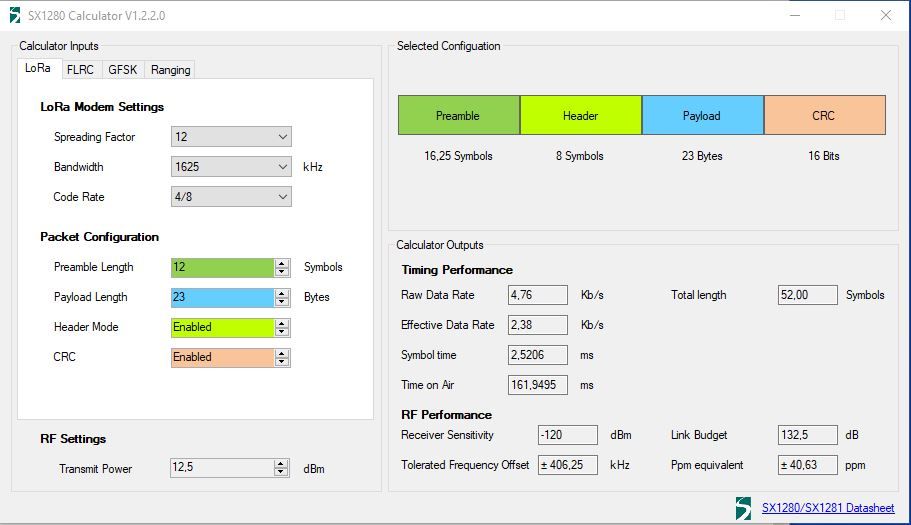
The directional sensitivity of the trace antenna is still a problem, so it'll have to wait until this Thursday, when the dipole antenna drives, to see whether the latest revision will be good enough or not.
-
Thanks to feedback from @mfalkvidd, I've constructed this as the new target:

The directional sensitivity of the trace antenna is still a problem, so it'll have to wait until this Thursday, when the dipole antenna drives, to see whether the latest revision will be good enough or not.
@NeverDie I am unable to find a better FCC reference than https://lowpowerlab.com/forum/rf-range-antennas-rfm69-library/fcc-rules-for-frequency-hopping/msg16006/?PHPSESSID=6e7efa8daee6de15d09c2b954879be34#msg16006 but that reference says:
The maximum allowed 20 dB bandwidth of the hopping channel is 500 kHz.
Since the module is now using 1,625 kHz bandwidth, it is again outside FCC rules.
-
https://www.govinfo.gov/content/pkg/CFR-2013-title47-vol1/pdf/CFR-2013-title47-vol1-sec15-247.pdf seems to be a pretty good reference.
@mfalkvidd How about this then?

I'm spitballing this. If anyone has a better idea, or a correction, please do post!
-
@mfalkvidd How about this then?

I'm spitballing this. If anyone has a better idea, or a correction, please do post!
-
I found an IPEX to SMA adapter, and so I changed the antenna selector to select the soldered on IPEX connector and then borrowed an antenna from an unused wifi base station and connected it to the Ebyte module, like so, just to see if it would work at all.

Doing this yielded a big improvement in Link Budget. Doing the same type of conversion on the LoRa transmitter module should make a noticeable difference, though I'm doubtful as to whether it will make enough of an improvement that it will perform as well as my AI-Thinker LoRa modules. Nonetheless, I'll attempt another, different, antenna hookup tomorrow when more antenna parts arrive from Amazon, and after testing it, I'll endeavor to reach a final conclusion.
Chasing down all these loose ends has been tedious, so if anyone finds this blog useful, please leave a thumbs-up to this posting. so that I know I'm not wasting my time writing it all down. At the moment I'm liking my AI-Thinker LoRa modules better: they have much better range and without all this fanfare they seem to "just work" straight out of the box.
-
It turns out Ebyte is kind enough to recommend specific antennas to use with this LoRa module:
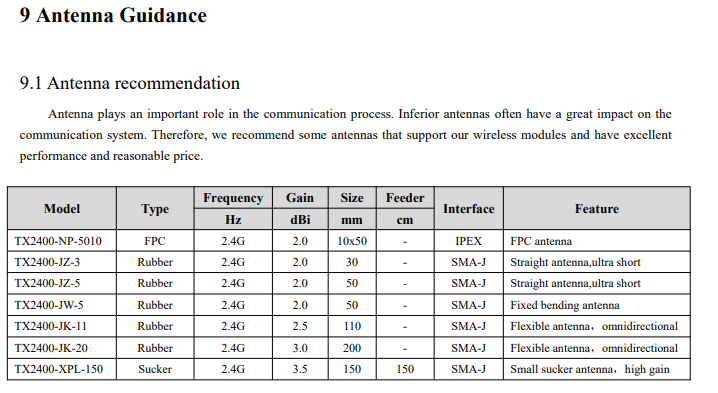
Unfortunately, these recommended antenna antenna models do not appear to be stocked by either Amazon or Mouser. Instead, it appears you may have to order them fromAliexpress:
https://www.ebyte.com/en/product-class.html?key=tx2400 So, your best bet would be to order the Ebyte antennas at the same time you order your Ebyte LoRa modules. Unfortunately, I didn't, and I'm now getting the distinct impression that ordering suitable antennas from Amazon is a crapshoot, because I've found supposedly different dipole antennas, but with the exact same dimensions, being marketed for both the 915Mhz band and for the 2.4Ghz band. Surely that can't be right?! :face_with_rolling_eyes: -
This is, allegedly, one of the TX2400-JW-5 antenna's that Ebyte recommends:
https://www.aliexpress.com/item/1005003096039403.html?spm=a2g0o.cart.0.0.63133c00YzHVcW&mp=1and this, it looks to me, is probably the same antenna, available on amazon:
https://www.amazon.com/gp/product/B093BVNPBW/ref=ppx_yo_dt_b_asin_title_o04_s00?ie=UTF8&th=1and which I'll be testing whenever it finally arrives from amazon (sometime soon). That way I'll be testing within manufacturer guidelines.
-
Reporting back: I first tried a dipole antenna bought on amazon (link above) that was allegedly for 2.4ghz:
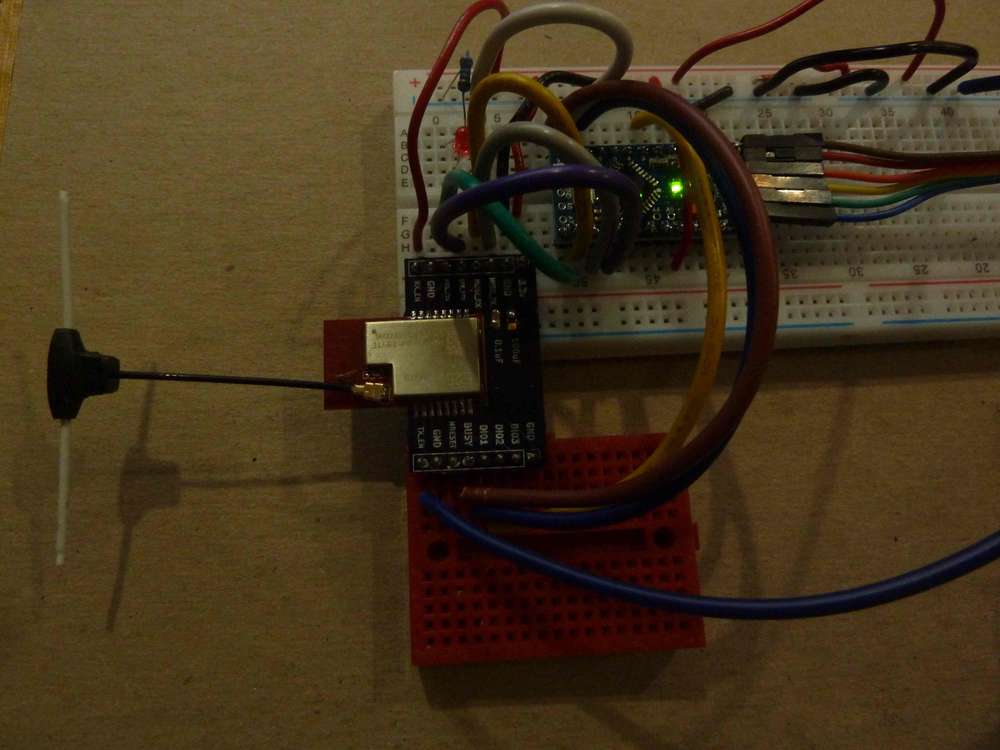
I put this on both the transmitter and the receiver. The good news is that the IPEX connector made a very snug fit with the EBYTE module, but the bad news is that the results were terrible:5s Hello World 1234567890*,CRC,DAAB,RSSI,-81dBm,SNR,-2dB,Length,23,Packets,1,Errors,0,IRQreg,8012 8s Hello World 1234567890*,CRC,DAAB,RSSI,-87dBm,SNR,-18dB,Length,23,Packets,2,Errors,0,IRQreg,8012 10s PacketError,RSSI,-78dBm,SNR,-20dB,Length,23,Packets,2,Errors,1,IRQreg,8052,IRQ_RX_DONE,IRQ_HEADER_VALID,IRQ_CRC_ERROR,IRQ_PREAMBLE_DETECTED 13s PacketError,RSSI,-78dBm,SNR,-14dB,Length,23,Packets,2,Errors,2,IRQreg,8052,IRQ_RX_DONE,IRQ_HEADER_VALID,IRQ_CRC_ERROR,IRQ_PREAMBLE_DETECTED 15s Hello World 1234567890*,CRC,DAAB,RSSI,-87dBm,SNR,-16dB,Length,23,Packets,3,Errors,2,IRQreg,8012 18s PacketError,RSSI,-80dBm,SNR,-7dB,Length,23,Packets,3,Errors,3,IRQreg,8052,IRQ_RX_DONE,IRQ_HEADER_VALID,IRQ_CRC_ERROR,IRQ_PREAMBLE_DETECTED 32s PacketError,RSSI,-80dBm,SNR,-14dB,Length,23,Packets,3,Errors,4,IRQreg,8052,IRQ_RX_DONE,IRQ_HEADER_VALID,IRQ_CRC_ERROR,IRQ_PREAMBLE_DETECTED 40s PacketError,RSSI,-85dBm,SNR,-21dB,Length,23,Packets,3,Errors,5,IRQreg,8052,IRQ_RX_DONE,IRQ_HEADER_VALID,IRQ_CRC_ERROR,IRQ_PREAMBLE_DETECTED 41s PacketError,RSSI,-86dBm,SNR,-17dB,Length,23,Packets,3,Errors,6,IRQreg,8052,IRQ_RX_DONE,IRQ_HEADER_VALID,IRQ_CRC_ERROR,IRQ_PREAMBLE_DETECTED 101s RXTimeout 106s PacketError,RSSI,-72dBm,SNR,-12dB,Length,23,Packets,3,Errors,7,IRQreg,8052,IRQ_RX_DONE,IRQ_HEADER_VALID,IRQ_CRC_ERROR,IRQ_PREAMBLE_DETECTED 114s PacketError,RSSI,-75dBm,SNR,-11dB,Length,23,Packets,3,Errors,8,IRQreg,8052,IRQ_RX_DONE,IRQ_HEADER_VALID,IRQ_CRC_ERROR,IRQ_PREAMBLE_DETECTED 116s PacketError,RSSI,-76dBm,SNR,-11dB,Length,23,Packets,3,Errors,9,IRQreg,8052,IRQ_RX_DONE,IRQ_HEADER_VALID,IRQ_CRC_ERROR,IRQ_PREAMBLE_DETECTEDSo, time to finally try the factory recommended antenna (also linked above). Unfortunately, the IPEX to SMA adapter I got was the wrong kind (female SMA instead of male SMA), so I had to fall back onto the only one Ipex-to-male-sma adapter I had. So, I put that on the receiver and left the transmitter with the dubious dipole antenna:
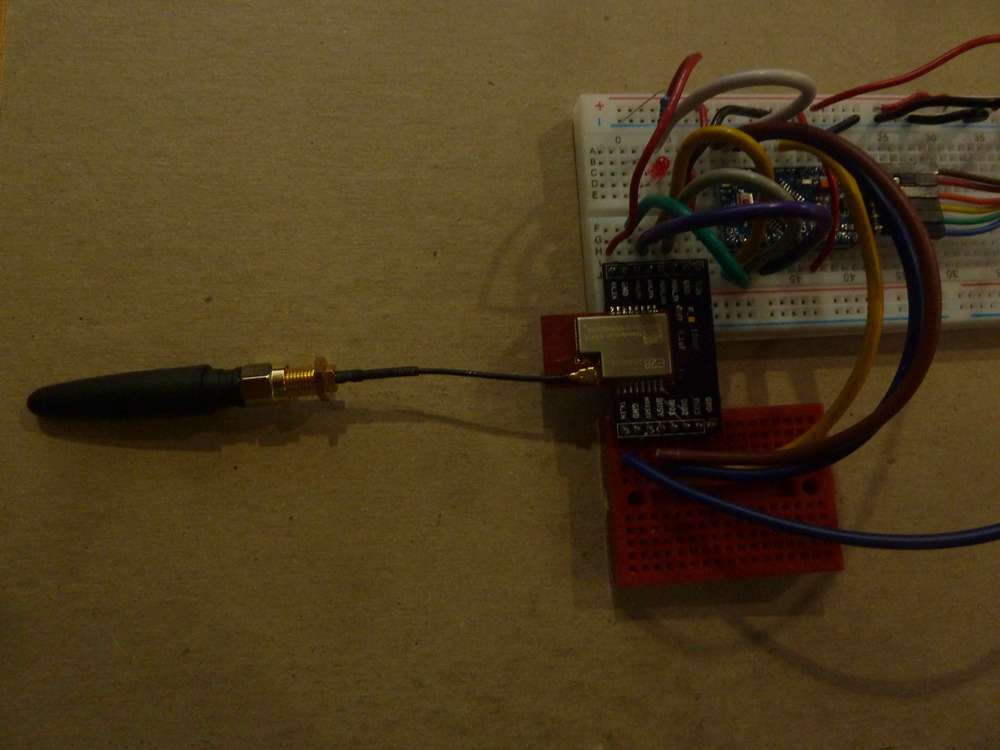
More bad news was that the IPEX connector on this adapter made a rather loosey-goosey connection to the Ebyte module. How can that be? Are there different sizes/types of IPEX connectors or something? But, I went with it anyway because it's all I have at the moment, and the good news is that the result was tangible improvement:4s Hello World 1234567890*,CRC,DAAB,RSSI,-67dBm,SNR,-3dB,Length,23,Packets,1,Errors,0,IRQreg,8012 6s PacketError,RSSI,-67dBm,SNR,-2dB,Length,23,Packets,1,Errors,1,IRQreg,8052,IRQ_RX_DONE,IRQ_HEADER_VALID,IRQ_CRC_ERROR,IRQ_PREAMBLE_DETECTED 7s Hello World 1234567890*,CRC,DAAB,RSSI,-72dBm,SNR,-11dB,Length,23,Packets,2,Errors,1,IRQreg,8012 9s Hello World 1234567890*,CRC,DAAB,RSSI,-66dBm,SNR,-3dB,Length,23,Packets,3,Errors,1,IRQreg,8012 10s Hello World 1234567890*,CRC,DAAB,RSSI,-67dBm,SNR,-2dB,Length,23,Packets,4,Errors,1,IRQreg,8012 11s Hello World 1234567890*,CRC,DAAB,RSSI,-71dBm,SNR,-7dB,Length,23,Packets,5,Errors,1,IRQreg,8012 13s Hello World 1234567890*,CRC,DAAB,RSSI,-66dBm,SNR,2dB,Length,23,Packets,6,Errors,1,IRQreg,8012 15s PacketError,RSSI,-68dBm,SNR,-6dB,Length,23,Packets,6,Errors,2,IRQreg,8052,IRQ_RX_DONE,IRQ_HEADER_VALID,IRQ_CRC_ERROR,IRQ_PREAMBLE_DETECTED 18s Hello World 1234567890*,CRC,DAAB,RSSI,-66dBm,SNR,-5dB,Length,23,Packets,7,Errors,2,IRQreg,8012 19s PacketError,RSSI,-71dBm,SNR,-14dB,Length,23,Packets,7,Errors,3,IRQreg,8052,IRQ_RX_DONE,IRQ_HEADER_VALID,IRQ_CRC_ERROR,IRQ_PREAMBLE_DETECTED 20s Hello World 1234567890*,CRC,DAAB,RSSI,-64dBm,SNR,0dB,Length,23,Packets,8,Errors,3,IRQreg,8012 23s Hello World 1234567890*,CRC,DAAB,RSSI,-65dBm,SNR,0dB,Length,23,Packets,9,Errors,3,IRQreg,8012 25s Hello World 1234567890*,CRC,DAAB,RSSI,-66dBm,SNR,1dB,Length,23,Packets,10,Errors,3,IRQreg,8012 28s Hello World 1234567890*,CRC,DAAB,RSSI,-65dBm,SNR,-3dB,Length,23,Packets,11,Errors,3,IRQreg,8012 29s Hello World 1234567890*,CRC,DAAB,RSSI,-73dBm,SNR,-10dB,Length,23,Packets,12,Errors,3,IRQreg,8012 30s Hello World 1234567890*,CRC,DAAB,RSSI,-71dBm,SNR,-10dB,Length,23,Packets,13,Errors,3,IRQreg,8012 32s PacketError,RSSI,-66dBm,SNR,-15dB,Length,23,Packets,13,Errors,4,IRQreg,8052,IRQ_RX_DONE,IRQ_HEADER_VALID,IRQ_CRC_ERROR,IRQ_PREAMBLE_DETECTED 33s Hello World 1234567890*,CRC,DAAB,RSSI,-71dBm,SNR,-9dB,Length,23,Packets,14,Errors,4,IRQreg,8012 34s Hello World 1234567890*,CRC,DAAB,RSSI,-75dBm,SNR,-12dB,Length,23,Packets,15,Errors,4,IRQreg,8012 36s Hello World 1234567890*,CRC,DAAB,RSSI,-74dBm,SNR,-10dB,Length,23,Packets,16,Errors,4,IRQreg,8012 37s Hello World 1234567890*,CRC,DAAB,RSSI,-67dBm,SNR,-1dB,Length,23,Packets,17,Errors,4,IRQreg,8012 38s PacketError,RSSI,-72dBm,SNR,-20dB,Length,23,Packets,17,Errors,5,IRQreg,8052,IRQ_RX_DONE,IRQ_HEADER_VALID,IRQ_CRC_ERROR,IRQ_PREAMBLE_DETECTED 39s PacketError,RSSI,-68dBm,SNR,-5dB,Length,23,Packets,17,Errors,6,IRQreg,8052,IRQ_RX_DONE,IRQ_HEADER_VALID,IRQ_CRC_ERROR,IRQ_PREAMBLE_DETECTED 42s Hello World 1234567890*,CRC,DAAB,RSSI,-71dBm,SNR,-7dB,Length,23,Packets,18,Errors,6,IRQreg,8012What's immediately evident is a big improvement in both the RSSI and the SNR. Bear in mind that this improvement is with the factory recommended antenna on only the receiver module. The seemingly lousy dipole antenna is still on the transmitter module.
So.... next step is to order the right kind of IPEX to male SMA connector and see how it fares when the factory recommended antenna is connected to both the transmitter module and the receiver modules.
-
A related topic is: just what kind of component is the antenna selector anyway?

My measurements suggest it is just a zero ohm resistor. It's very tiny, however, which makes it difficult to desolder and then re-solder to the right pads when changing the selection. I did do that on the receiver module, but on the transmitter module I removed the selector component and then used a solder bridge to enable the IPEX antenna connector and disable the trace antenna.
